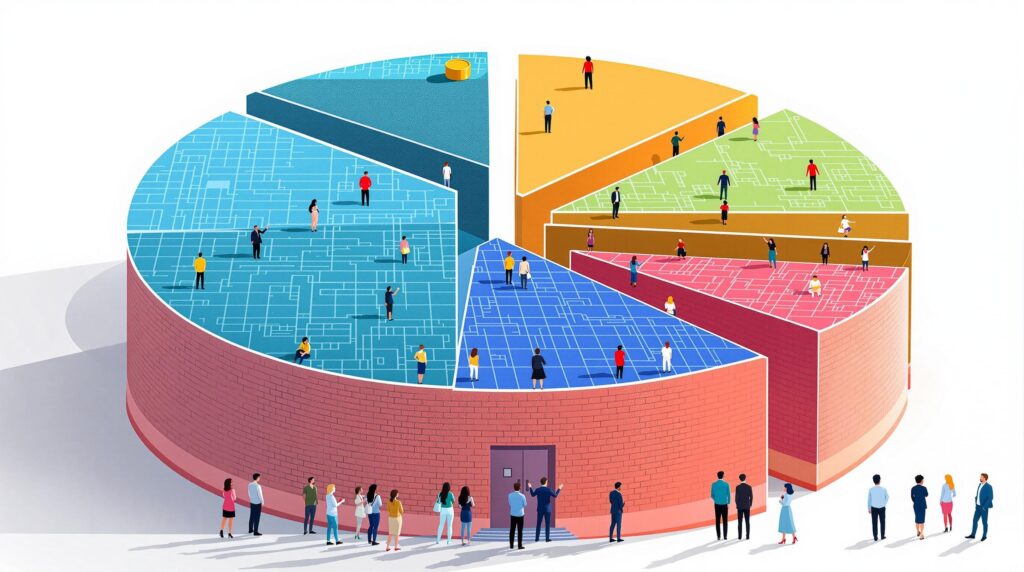[rev_slider alias=”slider-1″][/rev_slider]
Understanding the Blockchain Trilemma
In the world of blockchain technology, there’s a persistent challenge known as the Blockchain Trilemma. But what exactly is it? The trilemma refers to the difficulty in achieving a perfect balance between decentralization, security, and scalability within a blockchain network. These three components are critical to the success and functionality of blockchain systems, yet optimizing one often diminishes the effectiveness of the others. Let’s delve deeper into each element and their inherent challenges.
Decentralization
Decentralization is the essence of blockchain technology. It ensures that no single entity has control over the network, promoting fairness and reducing the risk of corruption or manipulation. However, enhancing decentralization can lead to challenges in scalability, as more nodes in a network tend to increase the time needed for consensus and transaction validation.
What is decentralization in blockchain? Decentralization in blockchain means distributing power across multiple nodes, preventing any single point of control or failure, thereby increasing the network’s reliability and trustworthiness.
To underline the significance, consider how traditional financial systems are centralized, relying heavily on intermediary institutions. Blockchain aims to eliminate such intermediaries, enabling direct peer-to-peer interactions. Yet, achieving perfect decentralization can be like balancing a chair on one leg – it’s possible but barely steady.
Security
Security is paramount for any blockchain to protect against attacks and fraud. Higher security typically means stronger encryption and consensus mechanisms which can sometimes slow down the network, affecting scalability. For example, Bitcoin uses a highly secure consensus mechanism called Proof of Work (PoW), but this necessitates substantial computational power and time, affecting transaction speeds.
How does blockchain ensure security? Blockchain security is maintained through cryptographic techniques and consensus algorithms that validate transactions and prevent unauthorized alterations.
Maintaining security in a decentralized environment involves constant vigilance against potential threats. This often requires complex and resource-intensive processes, balancing the risk of slower transaction speeds or higher energy consumption.
Scalability
Scalability refers to a blockchain’s ability to handle a growing number of transactions. It’s like trying to squeeze more cars onto a busy highway – the more cars there are, the slower the traffic moves. As blockchains such as Bitcoin and Ethereum grow in popularity, the need for enhanced scalability becomes critical.
What does scalability mean in blockchain? Scalability in blockchain is the capacity to process more transactions at a faster rate as the network grows.
The ongoing innovations in Layer 1 and Layer 2 solutions address these scalability challenges by improving transaction speeds and network efficiency. Solutions like sharding or iterations of the Proof of Stake (PoS) algorithm are promising avenues for overcoming these hurdles.
Balancing the Trilemma
The crux of the blockchain trilemma is effectively balancing decentralization, security, and scalability. Each blockchain project attempts to solve this in its unique way, often compromising one element to enhance the others. For instance, Ethereum 2.0 aims to address scalability while preserving decentralization and security through its shift from PoW to PoS consensus mechanism.
Jara, with its strategic focus on Layer 1 solutions, is innovatively engaging with these challenges to support a robust digital asset ecosystem in Africa. The integration of Jara’s L2 solutions, designed specifically for efficient transaction processing and enhanced security, showcases how Layer 1 solutions are crucial to overcoming such challenges in an emerging market.
The quest to balance the blockchain trilemma is an ongoing journey that requires continuous innovation and adaptation. By prioritizing and strategically managing these elements, blockchain networks like Jara are progressively achieving this intricate balance to support Africa’s transformative digital asset economy.
Introduction to Layer 1 Blockchains
Layer 1 blockchains are the foundational layer of the blockchain ecosystem. They form the bedrock upon which entire blockchain systems are built, providing the essential infrastructure for decentralized applications and services. But what exactly makes these Layer 1 blockchains so crucial, especially in the context of addressing the well-known blockchain trilemma?
What is the blockchain trilemma? The blockchain trilemma is a theoretical problem that states it is difficult for decentralized networks to achieve all three central characteristics: security, decentralization, and scalability at once.
In essence, the blockchain trilemma challenges developers to enhance a blockchain’s scalability without compromising on its security or decentralization. Many existing blockchain networks struggle to effectively address all three components simultaneously. Layer 1 blockchains like Bitcoin and Ethereum tackle this trilemma head-on by innovating at the base layer.
Key Infrastructure Elements: At their core, Layer 1 blockchains handle everything from transaction processing to consensus protocols. Here’s how they typically operate:
- Consensus Mechanisms: Most Layer 1 blockchains use consensus protocols like Proof of Work (PoW) or Proof of Stake (PoS) to validate transactions securely.
- Scalability Solutions: Whether through sharding or Segregated Witness (SegWit), improvements at the protocol level aim to increase transaction speeds and support higher volumes without degradation.
- Security Protocols: Implementing robust cryptographic standards ensures the integrity of transactions and the overall security of the network.
The infrastructure provided by Layer 1 solutions is pivotal in ensuring that networks remain secure and efficient, even as they scale. Beyond these basics, it’s also about maintaining a balance that won’t jeopardize the decentralized nature of the blockchain. As blockchain technology is rapidly evolving, these Layer 1 systems are crucial in laying the groundwork for more advanced solutions like Layer 2, which aspire to alleviate pressure by building on top of these foundational layers.
Innovations in Layer 1 blockchains are key to overcoming the scalability issues faced by many networks today, paving the way for more efficient and inclusive blockchain applications in regions like Africa.
Given the growing demand for accessible financial services in Africa, as highlighted by Jara’s initiatives, these technological improvements are not just about creating stronger blockchains but also about fostering economic empowerment through digital assets. With the $JARA token, for example, these advances are transforming traditional asset management and opening up new avenues for investment.
Exploring these Layer 1 innovations further will reveal how they hold potential for transforming the digital landscape, especially in emerging markets where the need for secure, scalable, and decentralized solutions is more pressing than ever. Through strategic implementations and continued development, Layer 1 blockchains are poised to significantly contribute to solving the blockchain trilemma and unlocking unprecedented opportunities.
[rev_slider alias=”text-call-cta”][/rev_slider]
Comparing Layer 1 and Layer 2 Solutions
Strengths and Limitations
In the fascinating world of blockchains, Layer 1 and Layer 2 solutions play vital roles in addressing what is known as the blockchain trilemma. This trilemma refers to the challenge of balancing decentralization, security, and scalability within a blockchain network. Although both layers are designed to improve blockchain efficiency, they take distinct approaches to achieve these goals. Let’s dive into their strengths and potential limitations.
- Layer 1: The Backbone – Layer 1 blockchains are the foundational networks like Bitcoin and Ethereum. They manage their ecosystem’s entire operation. Built for strong security and decentralization, they often face challenges with scalability. That’s why innovations like proof-of-stake and sharding have emerged, aiming to improve transaction throughput and reduce congestion.
- Layer 2: The Scalability Stewards – Layer 2 solutions act as accomplices to Layer 1 blockchains by handling transactions off-chain, thus reducing the load and enhancing scalability. They aim to expedite transaction processes and lower costs, making networks more efficient without sacrificing security. Take the Lightning Network for Bitcoin; it’s a classic Layer 2 solution.
Layer 1 blockchains are like a stable highway comprising multiple lanes while Layer 2 solutions act as express lanes that alleviate traffic and speed up the journey.
One might wonder, how do these layers fundamentally complement each other? Well, while Layer 1 networks focus on strengthening the decentralized and secure core, Layer 2 solutions extend their capabilities by offering faster transactions and reduced fees. However, the synergy between these layers demands careful management to maintain the balance of the trilemma.
What is the Blockchain Trilemma? The blockchain trilemma, coined by Ethereum’s co-founder Vitalik Buterin, refers to the difficult balancing act between decentralization, security, and scalability within blockchain networks.
Despite their advantages, each layer has its limitations. Layer 1’s improvements, such as protocol upgrades, are often lengthy and well-considered but can be slow to implement. On the other hand, Layer 2 solutions, while effective, still rely on Layer 1 security, and require strong integration and cooperation to function optimally alongside existing networks.
- Decentralization Challenges: Layer 1 networks prioritize decentralized control which can slow coordination and development efforts, sometimes delaying essential updates.
- Security Dependence: Layer 2 solutions need to ensure that off-chain transactions are protected, which mainly depends on the integrity and security of the underlying Layer 1 blockchain.
- Interoperability: Making Layer 2 solutions compatible across different Layer 1 systems can be complex and requires continuous development and standardization.
Both Layer 1 and Layer 2 solutions have their roles to play in evolving the blockchain landscape. They cater to different needs but, when implemented harmoniously, they forge a potent combination capable of overcoming the blockchain trilemma and laying the path for future innovations.
If you’re curious how these advancements benefit real-world applications, consider looking into Jara’s innovative ecosystem. Their proprietary Layer 2 blockchain is optimized specifically for Africa’s emerging digital asset economy, bridging global capital to African assets. With Jara’s solutions, investors have the opportunity to partake in Africa’s digital revolution while benefiting from the dual layers’ combined strengths.
“Fueling Africa’s Digital Asset Economy: With strategic $JARA token investment, you’re embracing Africa’s bold step toward economic empowerment through advanced blockchain technology.”
For more interesting insights on blockchain applications and security, learn about the legal implications surrounding cryptocurrency and blockchain technology.
The Future of Blockchain Scalability
Blockchain technology is a rapidly evolving domain, and one of the most pressing challenges it faces is achieving scalability without compromising security or decentralization. This dilemma is known as the Blockchain Trilemma, a concept introduced by Ethereum’s co-founder, Vitalik Buterin. So, how do Layer 1 blockchains contribute to solving this trilemma and what can we expect in the future?
What is the Blockchain Trilemma? The Blockchain Trilemma refers to the challenge of achieving scalability, security, and decentralization simultaneously within blockchain technology.
Layer 1 blockchains, also known as base-layer blockchains, form the foundation upon which everything else is built. They are responsible for the core functions like transaction validation and consensus. Recent innovations in Layer 1 technologies focus primarily on increasing scalability to handle more transactions per second, a crucial factor as adoption grows. But how are these advancements shaping the future of blockchain?
Emerging Trends in Layer 1 Blockchain Technologies
With Africa poised to bridge its digital assets economy with global capital, innovations in blockchain scalability are particularly relevant. Here are some significant trends and technologies anticipated to revolutionize Layer 1 blockchains:
- Sharding: A process that divides the blockchain into smaller, manageable pieces called “shards.” Each shard processes its transactions, enabling parallel transaction processing and drastically increasing throughput.
- Proof-of-Stake (PoS): An alternative to the energy-intensive Proof-of-Work mechanism. PoS significantly reduces the energy required to operate blockchains, facilitating scalability by allowing more practical use of resources.
- Hybrid Consensus Models: Models combining different consensus protocols, such as PoS and Byzantine Fault Tolerance (BFT), to enhance the efficiency and security of the blockchain networks.
Innovations Paving the Way
As blockchain solutions evolve, Jara’s involvement in enhancing Africa’s digital future through infrastructure projects powered by $JARA serves as a remarkable case study. The infrastructure gap in Africa presents a unique opportunity for blockchain-based projects, acting as a catalyst for financial inclusion.
“Invest in $JARA: Fuel Africa’s $200B+ Digital Asset Economy and Participate in a Revolutionary Ecosystem.” – This initiative is designed to unleash the potential of blockchain technology to transform finance in developing regions.
The need for robust Layer 1 blockchain solutions in Africa is underscored by projects such as the $6 billion Lagos airport undertaking. These ventures not only highlight the potential of blockchain in resolving existing infrastructural challenges but also demonstrate the impact of technology in democratizing investment opportunities. The demand for scalable solutions that Layer 1 blockchains bring can reshape how transactions are handled, promising a decentralized future.
- Decentralized Finance (DeFi): Building a broad DeFi ecosystem on Layer 1 blockchains can stimulate economic growth by providing wider access to financial services.
- Real World Asset Tokenization: Tokenizing real-world assets enables them to be traded easily on a global scale, thus increasing liquidity and accessibility.
In the grand scheme of things, as Africa embraces a digital revolution, the influence of these technical advancements is monumental. Through strategic investments and participation, stakeholders have the opportunity to be part of the movement shaping a technologically advanced and inclusive future.
Why is scalability crucial for blockchain? Scalability in blockchain ensures that as the number of users increases, the network can handle the load efficiently without delays or increased costs.
The advent of Layer 1 innovations lays the groundwork for unprecedented growth. As these technologies continue to mature, they promise to push the boundaries of what is possible, offering not just financial inclusion but also an equitable platform for technological advancement in Africa and beyond.
[rev_slider alias=”schedule-consultation-btn”][/rev_slider]

What are the benefits of Layer 1 blockchains in addressing the Blockchain Trilemma?
Layer 1 blockchains offer significant benefits in tackling the Blockchain Trilemma by enhancing decentralization, security, and scalability. These blockchains establish the foundational infrastructure of a blockchain network, ensuring robust protocol-level functionalities. They aim to optimize performance while addressing the inherent limitations faced by blockchain systems.
How do Layer 1 and Layer 2 blockchains differ in solving scalability issues?
While Layer 1 blockchains focus on enhancing the core protocol to improve throughput and reduce bottlenecks, Layer 2 solutions build atop the existing blockchain to facilitate faster transactions. Layer 1 aims at fundamental improvements, whereas Layer 2 alleviates congestion without altering the original blockchain architecture. This distinction is crucial in understanding each layer’s role in scalability.
Can improving Layer 1 blockchains completely solve the Blockchain Trilemma?
Enhancements to Layer 1 blockchains alone cannot entirely solve the Blockchain Trilemma, as it involves balancing decentralization, security, and scalability – often at trade-offs. However, innovations in Layer 1 can serve as a critical foundation that, when combined with Layer 2 solutions, lead to more balanced and efficient blockchain environments.
Why is the Blockchain Trilemma important in the context of digital innovation?
The Blockchain Trilemma highlights the key challenges blockchain developers face in creating networks that are scalable, secure, and decentralized. Understanding this balance is crucial for digital innovation, as it influences the design of more efficient and adaptable blockchain systems capable of driving future advancements in technology and financial services.

Related Practice Areas
Here are some additional topics related to how Layer 1 Blockchains are solving the Blockchain Trilemma:
Hear From Our Clients
At the forefront of our Layer 1 blockchain solutions practice is a deep-seated commitment to client satisfaction. Each case is handled with utmost care, as echoed in the appreciative feedback from those we represent. You can read more 5-star reviews here.

[rev_slider alias=”slider-3″][/rev_slider]
[rev_slider alias=”slider-6″][/rev_slider]
Take Your First Step Toward Blockchain Innovation
As the digital landscape evolves, so do the opportunities to harness cutting-edge technology for revolutionary advancements. At Jara, our commitment to bridging global capital to African assets sets us apart as leaders in blockchain solutions. Partner with us to unlock the potential of blockchain innovation tailored to your needs.
“Your gateway to Next-Gen Blockchain Solutions – redefining the future with Jara.”
- $JARA: Bridging Global Capital to African Assets: Join us in exploring the forefront of blockchain technology with the Jara app, available for Android and iPhone.
- Forbes List – Innovative Tech Firms: Acknowledged among the top innovative tech firms in Africa, 2023. Forbes Official Site
- Blockchain Innovation Award: Recognized for outstanding contributions in blockchain technology, 2023, by the Global Tech Forum. Global Tech Forum Awards
- Top African Blockchain Solutions Provider: Listed among the best for 2023 by TechAfrica. TechAfrica
- Outstanding Blockchain Startups: Highlighted for excellence in emerging blockchain markets, 2023, by Emerging Tech Awards. Emerging Tech Awards
- Leading Innovators in FinTech: Celebrated for pioneering advancements in FinTech, noted by Innovative Finance Review, 2023. Innovative Finance Review
Don’t just take our word for it. Experience the innovation and expertise firsthand. Visit our website or get started directly with the Jara app on Android or iPhone.
Chinyere “Chi” Nnadi Bio
Founder and CEO, Jara | Blockchain Technology Specialist
Content Reviewed by Chi Nnadi and his Content Team. Chi is a visionary entrepreneur transforming Africa’s financial landscape through blockchain solutions. As the Founder and CEO of Jara, he develops advanced technological infrastructure that tokenizes African assets, bridging them to global markets. His proprietary Layer-2 blockchain technology brings the African digital asset market closer to international investors.
Our Content Review Process
Chi Nnadi along with Jara’s dedicated content team, pledge to offer top-notch material. Our content guidelines ensure thoroughness, reputable sources, unbiased scrutiny, among other quality metrics. Please let us know if there is anything you believe to be inaccurate.
















